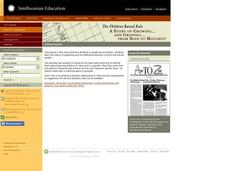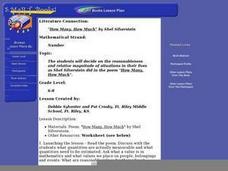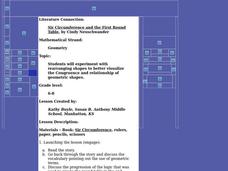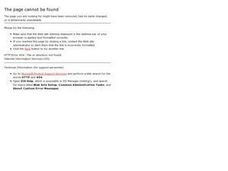Curated OER
Baga Drum
Students examine a Baga Drum in order to explore the history of the Baga people of West Africa. In this art history lesson, students recognize figures used in Baga Drum design that represent aspects of Baga culture. They also design and...
Curated OER
"How Tall, How Short, How Faraway" by David A. Adler
Students list in a journal what "measurement" is. They measure with standard and non-standard units and record data on a class chart. They also construct a meter tape.
Curated OER
"The King's Chessboard" by David Birch
Learners determine how a counting pattern is created is the story. They estimate how much rice is given to the wise man.
Curated OER
"Is There Room on the Bus?" by Helen Piers
Middle schoolers express answers as fractions, decimals, and percents.
Curated OER
Even and Odd Numbers
First graders recognize characteristics of odd and even numbers. They listen to the story "Bears Odd, Bears Even" and create a pictures showing comprehension of odd and even numbers.
Curated OER
"Alexander, Who Used to Be Rich Last Sunday" by Judith Viorst
Students figure out the probability that the penny's sixth toss be heads also. They figure the probability of having six coin tosses in a row all end on the same side.
Curated OER
"Alphabet City and City by Number" by Stephen T. Johnson; "Shapes, Shapes, Shapes" by Tana Hoban
Students review the definition of angles by identifying those in the classroom and putting them on a graphic organizer.
Curated OER
"Anno's Mysterious Multiplying Jar" by Masaichiro and Mitsumasa Anno
Students learn the meaning of the word "factorial" and how to apply the factorial concept to describe a special kind of numerical relationship.
Curated OER
"BATS on Parade" by Kathi Appelt
Young scholars correctly express and interpret mathematical facts, concepts, and procedures in symbolic, verbal and graphical form. They use a table to organize information.
Curated OER
"A Closet Full of Shoes" and Picture Puzzle Piece" by Shel Silverstein
Students explain the concept of simple probability.
Curated OER
"A Grain of Rice" by Helena Clare Pittman
Students solve the problem that comes up in the story. They realize the explosive growth of the powers of 2.
Curated OER
"How Big is a Foot?" by Rolf Myller
Students use estimation and fractions and standard units of measure to measure foot strips.
Curated OER
"How Many, How Much" by Shel Silverstein
Middle schoolers decide on the reasonableness and relative magnitude of situations in their lives as Shel Silverstein did in the poem "How Many, How Much."
Curated OER
"How Many Snails?" by Robert Wells
Middle schoolers represent algebraic patterns in various ways.
Curated OER
"Is a Blue Whale the Biggest Thing There Is?" by Robert Wells
Students discuss how big is big. They compare the area and perimeter of an acre and a football field.
Curated OER
"The Patchwork Quilt" by Valerie Flournoy pictures by Jerry Pinkney
Students recognize squares and find a pattern for counting squares.
Curated OER
"Pigs Will Be Pigs" by Amy Axelrod
Young scholars add, subtract, and multiply amounts of money.
Curated OER
"The Rajah's Rice: A Mathematical Folktale from India" adapted by David Barry
Learners use large numbers and learn exponential representation and explain patterns and relations of powers of 2.
Curated OER
"Sir Cumference and the First Round Table" by Cindy Neuschwander
Students experiment with rearranging shapes to better visualize the Congruence and relationship of geometric shapes.
Curated OER
"YIKES! Your Body Up Close" by Mike Janulewicz
Students use a Venn Diagram to analyze data from their class.
Curated OER
Cinderbank
Fourth graders identify major components of a "Cinderella" story in order to create a database.
Curated OER
"If You Hopped Like a Frog" by David M. Schwartz
Middle schoolers brainstorm several animal/personal scenarios, select one, and write out an explanation of the comparison. They apply the measurements/characteristics to themselves and use algebraic equations to demonstrate the comparison.
Curated OER
Sink or Float?
Young scholars predict and explore to discover which objects sink or float in fresh and salt water, predict how salt affect objects, write predictions on T chart, discuss difference between man-made and natural waters, and graph results.























